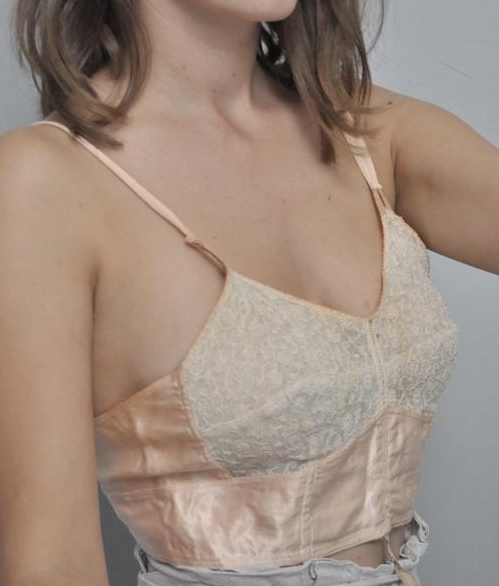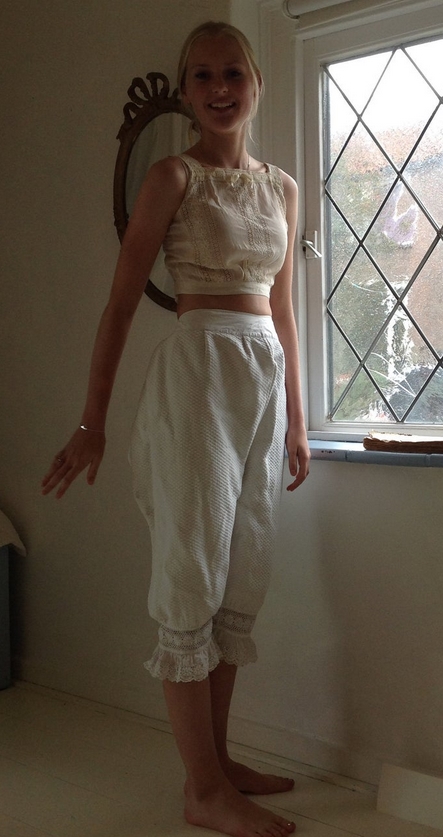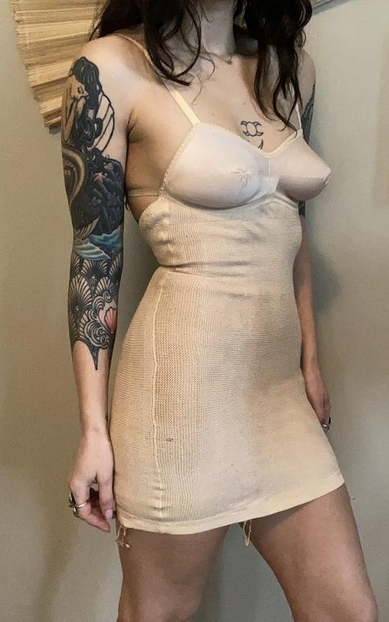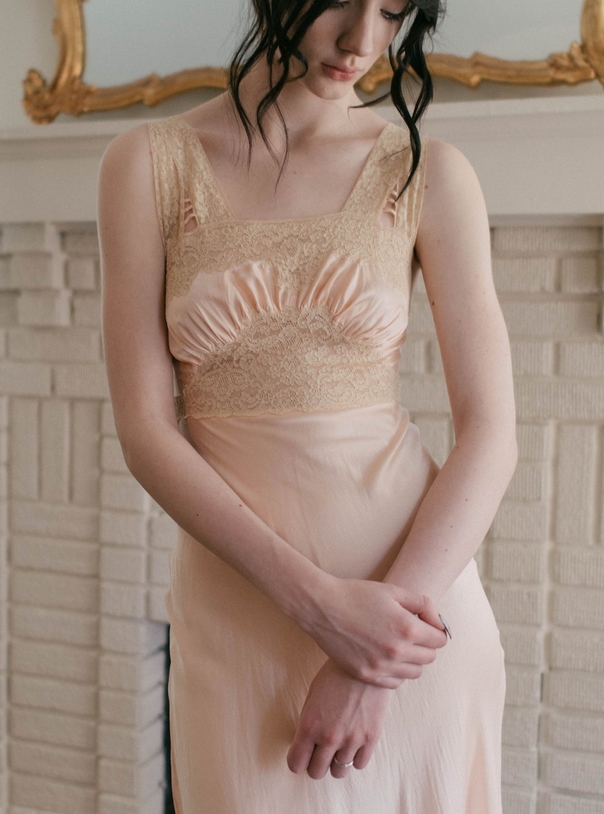Disclosure: This post may contain affiliate links. I receive a small commission at no cost to you when you make a purchase using my link.
From boyish figures to bodacious statement pieces, the transition from the ’20s into the 1930s lingerie styles and trends made a lasting impact on undergarment fashion for decades to come.
The fabrics got slippery with shiny silk, satin crepe, crepe de chine, yarn crepe, watered crepe mousseline, and satin georgette dominating and the silhouettes began to cling to curves. Small hooks and zippers were new additions to the 1930s Lingerie styles and trends to eliminate the possibility of bulging material. An elongated figure was still desirable but hemlines had dropped down and the waist went from below the breast line (high-waisted) back to the natural waist.
Piece by piece here’s how the women of the great depression redefined the feminine silhouette with the help of some choice 1930s lingerie.
Bras & Brassieres
Cups, cones, and pockets inside a well-supported bra is a dramatic difference from the shapeless and boxy style of the ’20s. The simple tube bra transformed into lingerie that was meant to lift and shape. Some included double linings for extra support.
Not all was lost from the 20s bra as The bandeau shape created in the 1930s was directly inspired by the minimalist bra except this one included a small panel in the lower center for separation and accentuation. It offered limited support and included dainty straps.

Cup bras were similar to the bandeau style except had inner cups, cones, or pocket lining for added definition and support. Breast were still minimized for bustier gals who opted for something more like a modern-day sports bra–stiff and shapeless.
Bloomers, Panties, & Briefs
1930’s underwear had a distinct design and detail to them. Lace trim or insets, embroidery, and small bows were all a part of the look. Among the most popular colors of 1930s panties were a variety of shades of light rose pink, peach, and white. The most common fabrics used were knit rayon, cotton, tricot, satin, and silk.

Bloomers were high-waisted, had elastic at the waist and knees. They were about 20 inches long and fell at or just above the knee cap which was appreciated for preventing thigh rub. Again we see a piece, similar to the ’20s, where functionality was a priority.
Step-in panties or “tap pants’, were also high-waisted but had variations in length and could be short, medium, or long. Differing from bloomers, panties in the 1930s would flair at the bottom as opposed to sinched.
Briefs made a debut in the mid-1930s and are the blueprint for modern-day full underwear. Briefs were high-waisted with ribbed seems that were fitted against the inner thigh and crotch area. The style was meant to target younger women–often marketed as “junior miss shorties”, although they found the forgettable pattern to be not savvy enough.
Step-in’s, Girdles, and Corsets
The step-in was an easy way to combine the essential 1930s lingerie into a single piece. Combining a bra, slip, and panty or bloomer, step-ins were cut on the bias, shaping the lingerie to the body and supporting the tailored dress of the thirties. Women ditched the step-in by the forties because it just became more of a hassle and wasn’t functional for bathroom use or breastfeeding.
“No real chic is possible, even with a dress tailored by a master dress designer, if your line is not prepared first.” Charmis ad, 1937

The 1930s girdle was essential for women who wanted to achieve a coveted flat tummy silhouette. However, it was understood that a girdle should no longer be unbearable for a woman to wear. Lastex, a material created in 1931, changed the approach. Girdles became comfortable and were able to be worn to play sports or for a ball gown. Worn from bust to thigh, the revolutionary new girdle was no longer boned but still allowed clothes to fit like a glove.
Nevertheless, a well-to-do woman usually owned three separate girdles–one for sport, one to wear out and about, and the third for formal occasions. Girdles had less to do with shaping and more to do with flattening the tummy and garter clips to keep stockings in place.
The girdle suited slender women comfortably, if you had the least amount of extra flesh, spillage would occur at the top or bottom. The corset and corselet provided a more solid shaping method. Most designs aimed to improve breathability and flexibility and to provide a foundation for the dress to hang smoothly.

The corset came in its own version of an all-in-one with a bra and girdle attached together called a corselet. All-in-one corselets were the preferred 1930s lingerie piece fit for evening wear or fancy afternoon dress. Backless and strapless corselettes were designed to go under the new backless and halter-topped evening gowns.
Slips, Stockings, and Style
The final outer layer in 1930s lingerie was the slip. Dresses got longer and so did the slip. Cut on the bias, slips in the 30s were clingy and thus dresses would cling to the slip. Straps were thin with a square, scoop, or V neckline. The bust and hem were commonly lined with delicate lace. The taffeta slip with ruffled hem rustled under formal gowns and dresses elevating the glamour factor of a nighttime look. Petticoats were less common but available for women who wore long skirts.

Women in the 1930s continued to wear back seamed stockings (seamer stockings) just as they did in the 1920s. Colors were shades of nude, tan, or grey with various shades in between. Common color names from the era were suntan, copper, beige, town wear, sunburn brown, taupe, gunmetal, smoke, cloud, and white. Women of color only found dark grey or dark tan to be suitable. Knee-high stockings were a more comfortable alternative to full stockings. Made of the same silk, cotton, or rayon material, the knit tops held them up over the calf.
Buying 1930’s Vintage Lingerie
Reproduction of 1930s lingerie is rare and has become so collectible that the price point isn’t reasonable for most people, but you can still find authentic vintage pieces online (or sewing patterns for DIY).
I like to shop on Etsy for vintage lingerie pieces, there is an array of popular shops to choose from. Some of my favorite shops include:
- The Kissing Tree – Gorgeous photos and an exquisite curation of well-kept vintage lingerie pieces.
- Forty Treasures – Offering beautiful antique clothing.
- House of Pretty Parlor – Carries lovely hand-selected vintage garments from the 1920s through the 1990s.
- Spoon Vintage – Featuring one of a kind vintage clothing from the 1900s to the 1990s.
- Dressed in History – Offering highly wearable, beautifully designed garments from the 1900’s onwards.
- Silkworm Vintage – This shop has been featured in British Vogue Magazine.
- Vivian Elise Vintage – One-of-a-kind gowns & accessories.
Conclusion
The era of the 1930s was significant in its approach to lingerie and continues to inspire the modern woman. Be sure to check out the Etsy shops above for some of your own vintage inspiration.
I hope you found this article helpful! What do you think of 1930s lingerie styles and trends? Let us know in the comments below how you will rock this look!




Hi, thank you for sharing this article with us. I have been reading through the article”1930’S LINGERIE STYLES & TRENDS” I really find it very well structured. Beautifully explained and described for everyone understanding. I love also that you provide the links straight to the point/object where I can purchase, thank you for this.
It is true that the fashion from the year of 1930 is making a come back and many people returned to that. I completely agree with you regarding this. Unfortunately, I do not have experience with this. Thank you.
I was just reading about lingerie from the 1920s and I decided to continue scrolling your site. It seems as there were some things that improved, style wise in the 1930s. But in my opinion, others when backwards. It’s good that we in the 2020s can get to pick the best from both,